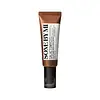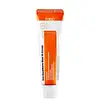What's inside
What's inside
 Key Ingredients
Key Ingredients

 Benefits
Benefits

 Concerns
Concerns

 Ingredients Side-by-side
Ingredients Side-by-side

Galactomyces Ferment Filtrate
HumectantGlycerin
HumectantCetyl Ethylhexanoate
EmollientPropanediol
SolventDicaprylyl Carbonate
Emollient1,2-Hexanediol
Skin ConditioningBetaine
HumectantCetearyl Alcohol
EmollientPolyglyceryl-10 Laurate
Skin ConditioningMethyl Trimethicone
Skin ConditioningSilica
AbrasiveCetearyl Olivate
Panthenol
Skin ConditioningPhenyl Trimethicone
Skin ConditioningPotassium Cetyl Phosphate
EmulsifyingWater
Skin ConditioningSorbitan Olivate
EmulsifyingBisabolol
MaskingAmmonium Polyacryloyldimethyl Taurate
Emulsion StabilisingHydroxyethyl Acrylate/Sodium Acryloyldimethyl Taurate Copolymer
Emulsion StabilisingDipropylene Glycol
HumectantSqualane
EmollientLaminaria Japonica Extract
Skin ProtectingEclipta Prostrata Leaf Extract
Skin Conditioning3-O-Ethyl Ascorbic Acid
Skin ConditioningGlutathione
Ethylhexylglycerin
Skin ConditioningParfum
MaskingLavandula Angustifolia Oil
MaskingCoptis Japonica Root Extract
Skin ConditioningXanthan Gum
EmulsifyingButylene Glycol
HumectantAdenosine
Skin ConditioningFructooligosaccharides
HumectantSorbitan Isostearate
EmulsifyingT-Butyl Alcohol
PerfumingHydrogenated Lecithin
EmulsifyingBeta-Glucan
Skin ConditioningHydrolyzed Hyaluronic Acid
HumectantAscorbic Acid
AntioxidantTocopherol
AntioxidantAllantoin
Skin ConditioningCeramide NP
Skin ConditioningOryza Sativa Bran Oil
EmollientOryza Sativa Bran Extract
Skin ConditioningGlyceryl Stearate
EmollientPhytosphingosine
Skin ConditioningCholesterol
EmollientCeramide AP
Skin ConditioningCeramide As
Skin ConditioningCeramide Ns
Skin ConditioningCaprylyl Glycol
EmollientCeramide Ng
Skin ConditioningCeramide EOP
Skin ConditioningLinalool
PerfumingLimonene
PerfumingGalactomyces Ferment Filtrate, Glycerin, Cetyl Ethylhexanoate, Propanediol, Dicaprylyl Carbonate, 1,2-Hexanediol, Betaine, Cetearyl Alcohol, Polyglyceryl-10 Laurate, Methyl Trimethicone, Silica, Cetearyl Olivate, Panthenol, Phenyl Trimethicone, Potassium Cetyl Phosphate, Water, Sorbitan Olivate, Bisabolol, Ammonium Polyacryloyldimethyl Taurate, Hydroxyethyl Acrylate/Sodium Acryloyldimethyl Taurate Copolymer, Dipropylene Glycol, Squalane, Laminaria Japonica Extract, Eclipta Prostrata Leaf Extract, 3-O-Ethyl Ascorbic Acid, Glutathione, Ethylhexylglycerin, Parfum, Lavandula Angustifolia Oil, Coptis Japonica Root Extract, Xanthan Gum, Butylene Glycol, Adenosine, Fructooligosaccharides, Sorbitan Isostearate, T-Butyl Alcohol, Hydrogenated Lecithin, Beta-Glucan, Hydrolyzed Hyaluronic Acid, Ascorbic Acid, Tocopherol, Allantoin, Ceramide NP, Oryza Sativa Bran Oil, Oryza Sativa Bran Extract, Glyceryl Stearate, Phytosphingosine, Cholesterol, Ceramide AP, Ceramide As, Ceramide Ns, Caprylyl Glycol, Ceramide Ng, Ceramide EOP, Linalool, Limonene
Hippophae Rhamnoides Fruit Extract 70%
Skin ConditioningGlycerin
HumectantMethylpropanediol
SolventCetyl Ethylhexanoate
EmollientSimmondsia Chinensis Seed Oil
Emollient1,2-Hexanediol
Skin ConditioningNiacinamide
SmoothingPolyglyceryl-3 Methylglucose Distearate
EmulsifyingCetearyl Alcohol
EmollientPhenyl Trimethicone
Skin ConditioningPanthenol
Skin ConditioningSodium Hyaluronate
HumectantPortulaca Oleracea Extract
Skin ConditioningCitrus Unshiu Extract
Skin ConditioningButylene Glycol
HumectantAdenosine
Skin ConditioningSorbitan Stearate
EmulsifyingGlyceryl Stearate Se
EmulsifyingMethyl Methacrylate Crosspolymer
Carbomer
Emulsion StabilisingArginine
MaskingAmmonium Acryloyldimethyltaurate/Vp Copolymer
Water
Skin ConditioningCaprylyl Glycol
EmollientEthylhexylglycerin
Skin ConditioningDisodium EDTA
Hippophae Rhamnoides Fruit Extract 70%, Glycerin, Methylpropanediol, Cetyl Ethylhexanoate, Simmondsia Chinensis Seed Oil, 1,2-Hexanediol, Niacinamide, Polyglyceryl-3 Methylglucose Distearate, Cetearyl Alcohol, Phenyl Trimethicone, Panthenol, Sodium Hyaluronate, Portulaca Oleracea Extract, Citrus Unshiu Extract, Butylene Glycol, Adenosine, Sorbitan Stearate, Glyceryl Stearate Se, Methyl Methacrylate Crosspolymer, Carbomer, Arginine, Ammonium Acryloyldimethyltaurate/Vp Copolymer, Water, Caprylyl Glycol, Ethylhexylglycerin, Disodium EDTA
Ingredients Explained
These ingredients are found in both products.
Ingredients higher up in an ingredient list are typically present in a larger amount.
1,2-Hexanediol is a synthetic liquid and another multi-functional powerhouse.
It is a:
- Humectant, drawing moisture into the skin
- Emollient, helping to soften skin
- Solvent, dispersing and stabilizing formulas
- Preservative booster, enhancing the antimicrobial activity of other preservatives
Adenosine is in every living organism. It is one of four components in nucleic acids that helps store our DNA.
Adenosine has many benefits when used. These benefits include hydrating the skin, smoothing skin, and reducing wrinkles. Once applied, adenosine increases collagen production. It also helps with improving firmness and tissue repair.
Studies have found adenosine may also help with wound healing.
In skincare products, Adenosine is usually derived from yeast.
Learn more about AdenosineButylene Glycol (or BG) is used within cosmetic products for a few different reasons:
Overall, Butylene Glycol is a safe and well-rounded ingredient that works well with other ingredients.
Though this ingredient works well with most skin types, some people with sensitive skin may experience a reaction such as allergic rashes, closed comedones, or itchiness.
Learn more about Butylene GlycolCaprylyl Glycol is a humectant and emollient, meaning it attracts and preserves moisture.
It is a common ingredient in many products, especially those designed to hydrate skin. The primary benefits are retaining moisture, skin softening, and promoting a healthy skin barrier.
Though Caprylyl Glycol is an alcohol derived from fatty acids, it is not the kind that can dry out skin.
This ingredient is also used as a preservative to extend the life of products. It has slight antimicrobial properties.
Learn more about Caprylyl GlycolCetearyl alcohol is a mixture of two fatty alcohols: cetyl alcohol and stearyl alcohol. It is mainly used as an emulsifier. Emulsifiers help prevent the separation of oils and products. Due to its composition, it can also be used to thicken a product or help create foam.
Cetearyl alcohol is an emollient. Emollients help soothe and hydrate the skin by trapping moisture.
Studies show Cetearyl alcohol is non-toxic and non-irritating. The FDA allows products labeled "alcohol-free" to have fatty alcohols.
This ingredient is usually derived from plant oils such as palm, vegetable, or coconut oils. There is debate on whether this ingredient will cause acne.
Due to the fatty acid base, this ingredient may not be Malassezia folliculitis safe.
Learn more about Cetearyl AlcoholCetyl Ethylhexanoate is an emollient ester. It comes from cetearyl alcohol and 2-ethylhexanoic acid.
Cetyl Ethylhexanoate is an emollient that adds a velvety feel to skin without being greasy or oily. Emollients help trap moisture into your skin, keeping your skin soft and hydrated.
Ethylhexylglycerin (we can't pronounce this either) is commonly used as a preservative and skin softener. It is derived from glyceryl.
You might see Ethylhexylglycerin often paired with other preservatives such as phenoxyethanol. Ethylhexylglycerin has been found to increase the effectiveness of these other preservatives.
Glycerin is already naturally found in your skin. It helps moisturize and protect your skin.
A study from 2016 found glycerin to be more effective as a humectant than AHAs and hyaluronic acid.
As a humectant, it helps the skin stay hydrated by pulling moisture to your skin. The low molecular weight of glycerin allows it to pull moisture into the deeper layers of your skin.
Hydrated skin improves your skin barrier; Your skin barrier helps protect against irritants and bacteria.
Glycerin has also been found to have antimicrobial and antiviral properties. Due to these properties, glycerin is often used in wound and burn treatments.
In cosmetics, glycerin is usually derived from plants such as soybean or palm. However, it can also be sourced from animals, such as tallow or animal fat.
This ingredient is organic, colorless, odorless, and non-toxic.
Glycerin is the name for this ingredient in American English. British English uses Glycerol/Glycerine.
Learn more about GlycerinPanthenol is a common ingredient that helps hydrate and soothe the skin. It is found naturally in our skin and hair.
There are two forms of panthenol: D and L.
D-panthenol is also known as dexpanthenol. Most cosmetics use dexpanthenol or a mixture of D and L-panthenol.
Panthenol is famous due to its ability to go deeper into the skin's layers. Using this ingredient has numerous pros (and no cons):
Like hyaluronic acid, panthenol is a humectant. Humectants are able to bind and hold large amounts of water to keep skin hydrated.
This ingredient works well for wound healing. It works by increasing tissue in the wound and helps close open wounds.
Once oxidized, panthenol converts to pantothenic acid. Panthothenic acid is found in all living cells.
This ingredient is also referred to as pro-vitamin B5.
Learn more about PanthenolPhenyl Trimethicone is a silicon-based polymer. It is derived from silica.
Phenyl Trimethicone is used as an emollient and prevents products from foaming.
As an emollient, it helps trap moisture in the skin. It is considered an occlusive.
Learn more about Phenyl TrimethiconeWater. It's the most common cosmetic ingredient of all. You'll usually see it at the top of ingredient lists, meaning that it makes up the largest part of the product.
So why is it so popular? Water most often acts as a solvent - this means that it helps dissolve other ingredients into the formulation.
You'll also recognize water as that liquid we all need to stay alive. If you see this, drink a glass of water. Stay hydrated!
Learn more about Water